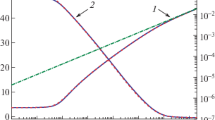Abstract
Thermal relaxation time constant is derived analytically for the relaxed model with unequal phase-temperatures of a vapour bubble at saturation temperature and a non-steady temperature field around the growing vapour bubble. The energy and state equation are solved between two finite boundary conditions. Thermal relaxation time perform a good agreement with Mohammadein (in Doctoral thesis, PAN, Gdansk, 1994) and Moby Dick experiment in terms of non-equilibrium homogeneous model (Bilicki et al. in Proc R Soc Lond A428:379–397, 1990) for lower values of initial void fraction. Thermal relaxation is affected by Jacob number, superheating, initial bubble radius and thermal diffusivity.







Similar content being viewed by others
References
Anderson DA, Tannehill JC, Pietcher RH (1984) Computational fluid mechanics and transfer. Hemisphere, Washington
Bauer EG, Houdayer GR, Sureau HM (1976) A non-equilibrium axial flow model and application to loss-of-coolant accident analysis: the CLYSTERE system code, “paper presented at the OECD/NEA specialists” meeting on Transient Two-Phase Flow, Toronto, Canada
Bilicki Z, Kestin J (1990) Physical aspects of the relaxation model in two-phase flow. Proc R Soc Lond A 428:379–397
Bilicki Z, Kestin J, Pratt MM (1990) A reinterpretation of the results of the Moby Dick experiment in terms of the non equilibrium model. J Fluid Eng Trans ASME 112:212–217
Bilicki Z, Kwidzinski R, Mohammadein SA (1996) An estimation of a relaxation time of heat and mass exchange in the liquid–vapour bubble flow. Int J Heat Mass Transfer 39(4):753–759
Hsieh DY (1965) Some analytical aspects of bubble dynamics. J Basic Eng ASME D87:991–1005
Madejski J, Staiszewski B (1971) Heat transfer in boiling and two-phase flow, vol l (in Polish). Osrodek Informacji o Energii Jadrowej, Warsaw
Mohammadein SA (1994) Evaluation of characteristic time in the relaxation model for one-component bubble-flow. Doctoral Thesis, PAN, Gdansk
Mohammadein SA, Sh A. Gouda temperature distribution in a mixture surrounding a growing vapour bubble. J Heat Mass Transfer. DOI 10.1007/s00231-004-0585-6
Prosperetti A, Plesset MS (1978) Vapour-bubble growth in a superheated liquid. J Fluid Mech 85:349–368
Reocreux M (1974) Contribution a l’etude des debits critiques en ecoulement diphasique eau vapeur. These, Univ. Scientifique et Medicale, Grenoble, France
Scriven LE (1959) On the dynamics of phase growth. Chem Eng Sci 10:1–13
Selmer - Olsen S (1991) Etude theoretique et experimentale des ecoulements diphasiques en tuyere convergente-divergence. These, de l’Institut National Polytechnique dGrenoble, France
Acknowledgements
The author is grateful to the reviewers for their useful comments
Author information
Authors and Affiliations
Appendix
Appendix
Evaluation of \(\bar{T}_{{\text{l}}} (\theta _{{\text{T}}} )\)
The average temperature \(\bar{T}_{{\text{l}}} (t_{{\text{i}}} )\) is estimated from temperature distribution around the growing of vapour bubble between two boundaries R(t i) and R m respectively as follows
where
Integrating by parts, Eq. 24 becomes
where
At, t i =θT, \(\frac{{{\text{d}}T_{{\text{l}}} (r,\theta _{{\text{T}}} )}} {{{\text{d}}r}} = \frac{{\partial T_{{\text{l}}} (r,\theta _{{\text{T}}} )}} {{\partial r}},\) then
Rights and permissions
About this article
Cite this article
Mohammadein, S.A. The derivation of thermal relaxation time between two-phase bubbly flow. Heat Mass Transfer 42, 364–369 (2006). https://doi.org/10.1007/s00231-004-0586-5
Received:
Published:
Issue Date:
DOI: https://doi.org/10.1007/s00231-004-0586-5



